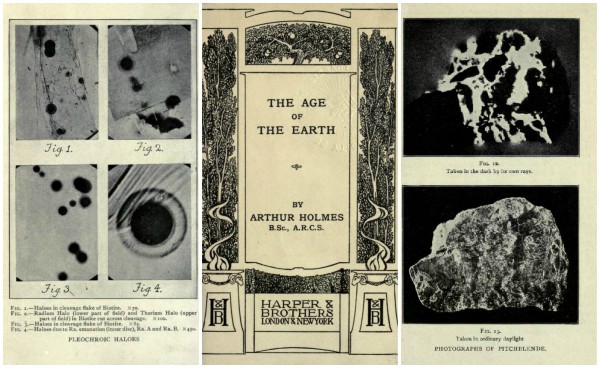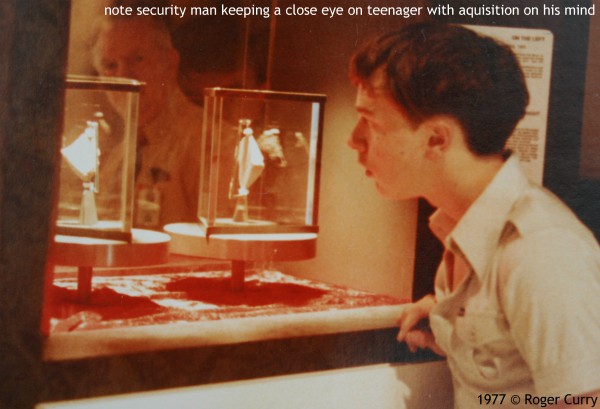
In terms of desirability, the specimens collected by NASA in ‘69 would be hard to beat. Their superb provenance is excellently documented. They are holotypes of three minerals new to science, and brave men risked their lives to collect them.
There were two expeditions to the Moon in 1969. Equipment wise, each required much more than the old car, geological hammer, beer and sarnies I myself use to collect terrestrial mineral specimens. Their transport was extreme, the food terrible, sanitation facilities worse than on the moors, and the weather was vacuous monotony. But they got some excellent specimens, so valuable that their private ownership is illegal. Unfortunately for e-Rocks :(
The crew of Apollo 11 returned to Earth on July 24th, 1969, with 47.51 lbs (21.55 kg) of rocks. Two months dragged by, before I saw moon rocks with my own eyes. This seemed like an eternity to an 10 year old science enthusiast and mineral collector!
I’d found the whole space program utterly absorbing, born just after Sputnik launched, I grew up in an atmosphere of dynamic human exploration and engineering optimism. Mineralogy was my main interest, closely followed by chemistry, physics and electronics. Nothing has changed. For my 10th birthday, I’d got a cloud chamber I wanted, not a bike. My parents didn’t have a clue what they’d bought me from Griffin & George. To get the cloud chamber working, I wrote a begging letter to ICI to get dry-ice. Tiring of looking at the alpha-particles’ tracks from the feeble radioactive source supplied, later that year I sent a letter to Durham University, addressed to “A Professor of Geology,” to ask for a small piece of pitchblende.
My plea for a radioactive source was fortunately answered by Professor Brown in Oct. ‘69, who very kindly sent me specimens of pitchblende, torbernite and monazite sand. How he had time to sort my needs out I’m not sure - unbeknownst to me, at the time he was up to the elbows in moon dust….
Professor Sir Malcolm Brown, 1925 - 97.

The opening paragraph of Prof. Brown’s obituary by Sir Kingsley Dunham -
“In 1967, Malcolm Brown, then Professor of Geology at Durham University, was appointed Nasa Principal Investigator of the Apollo Moon expeditions. The first lunar sample arrived in Durham in September 1969, where it was exhibited at the Gulbenkian Museum, and so great was the interest in this single representative of the lunar soil (regolith), that at times the queue of people wishing to see it extended for nearly a mile. The samples received in the laboratory, however, included not only the powdered soil, but actual samples of solid rock and thin and polished sections made from them. The investigation was mainly by physical means using X- ray fluorescence and electron microprobe equipment already installed in the new building occupied by the department. The results had a wide international circulation.”
I waited over four hours in the queue at the Gulbenkian Museum to examine what I’d seen Armstrong picking up off the lunar surface a couple of months before. Unnerving, because of armed guards, overwhelming because of what it was, the petri dish of lunar regolith was ordinary in appearance. Underwhelming dust with a smattering of gravel. It was only on show a couple of days, before landing in Prof. Brown’s lab who, a month later, spared the time from his lunar investigations, to send me some radioactives.
Over the years, I kept Prof. Brown informed about my radioactivity experiments and, in 1971, he sent me this letter, with an accompanying document entitled “Geochemistry of the Moon” by G.M.Brown, which is well worth a read, and is presented towards the end of this document -

The chap Prof. Brown mentions, Prof. Arthur Holmes, father of modern geochronology (he did the first accurate uranium-lead radiometric dating), was born in Hebburn, near Newcastle-upon-Tyne. After a severe attack of malaria whilst mineral prospecting in Mozambique, his death was reported in Britain. Fortunately he returned to prove his continued existence by publishing a hugely significant book, then ventured to Burma, as an oil company chief geologist. Returning to Britain in 1924 penniless, he curbed his wanderlust, and became head of the Department of Geology, Durham University. His seminal work, “The Age of the Earth,” can be read by clicking the image below.

Sorry,.... bit of a side-track there (although the age of moon rocks was determined by the radiometric dating techniques pioneered by Holmes),... back to matters lunar.. Until receiving the letter above from Prof. Brown, I hadn’t realised that he was the Lunar Samples Head Honcho at the Uni. Opportunity lost there Rog, I thought. But by then, from the lofty, mature perspective of a 12 year old, begging letters seemed a bit naff…. Mind you, a few microscopic specks of moon dust would have been a grand addition to my collection! Though it could have been the Prof’s knighthood down the drain!
The hardware
The Apollo Space Program, instigated to put a man on the moon with a hammer, was of extraordinary engineering complexity. We’ll just look at the hammer, and getting it off the earth.

The hammer flown on Apollo 11 and 12 had an overall length of 41 cm, a weight of 850 grams, a head length of 16 cm, and a head thickness of 3.8 cm. Materials for this and all Apollo tools had to be very carefully specified, to prevent undue contamination to specimens. This from “Catalog of Apollo Lunar Surface Geological Sampling Tools and Containers,” by JH Allton, NASA JSC-23454 -

Lifting the hammer off the ground, with its delivery system of Armstrong, Aldrin and Collins, needed five engines running off kerosene and liquid oxygen, each producing 690 tons of thrust..

The Specimens
Neil Armstrong’s priorities on the day man set foot on the moon, were firstly to land the Eagle, secondly to get a “contingency sample” of moon dust and rocks. Rock collecting came before flag-planting and setting up experiments! When the three astronauts returned to Earth with their finds, all work on the specimens was done in glove-boxes, the rocks and men being quarantined. They’d got some excellent specimens -

Fine grained lunar basalt with numerous vesicles.
(Armstrong sample 10022)
The samples at Durham Uni were not only examined by Prof. Brown and his squad, but folk at Newcastle Uni had a look in. Bert Randall F.R.S., a renowned petrologist, analysed the minerals. He was the guy who described the tholeiite dyke giant vesicles in a previous post. The big news, from the ‘69 rock collection extravaganza, was the description of three minerals, new to science - Tranquillityite, Armalcolite and Pyroxferroite.
Armalcolite, named after Armstrong, Aldrin & Collins, a titanium, magnesium and iron oxide, was later identified in terrestrial rocks, as were tranquillite & pyroxferroite. The NASA photographs of the lunar specimens of these specimens are a little disappointing, being petrological thin sections. Fortunately e-Rocks has rather nice photos of their terrestrial counterparts! -

Eight years after I’d seen moon dust at Durham, I flew over to the USA on Concorde (part of an engineering prize) and saw much more substantial lunar specimens. The cut rocks displayed at both the Smithsonian Air & Space museum, Washington DC, and at the Johnson Space Centre, Houston, were of a substantially more interesting nature mineralogically (glassy impact melt-breccia). However, the unforgettable experience for me was that first sight of moon dust, soon after its collection in ’69. But here’s an 18 year old me, still reasonably enthralled with what I was seeing -

And Lastly, My Dream Specimen :)
Most prized, and valuable item, I wish I’d obtained - a glass recessed microscope slide, with coverslip, containing visible black dust. Labelled “To R.G.Curry from G.M.Brown, 12.4ug lunar regolith, Mare Tranquillitatis, collected by N.Armstrong, 21.07.69” Such are dreams…..
Perhaps I should make such a slide, complete with faux moondust and authentic looking label, then auction it, clearly described as “a hoax, forgery and for amusement purposes only” here on e-Rocks? Instead of doing the job properly, and shelling out 25 quid on a fragment of a lunar meteorite off eBay, to bash down into “authentic” lunar regolith, I’d just use crap from the bottom of my barbeque. I could sell it complete with the letter from Prof. Brown and the printed article he sent me, as “provenance.” Watch this space!
Or perhaps not. NASA, with the help of the FBI, CIA and Interpol, aggressively investigate anyone attempting to sell their missing lunar material (there’s over 180 unaccounted moon rocks out there somewhere). They might think such an auction a triple bluff, and I don’t want men in suits and shoulder holsters barging about, rummaging through my junk!
Here’s Professor Sir Malcolm Brown’s brilliant article, “Geochemistry of the Moon” -





Lastly, here’s the letter Prof. Brown sent to my Dad (nowt to do with lunar material), to reassure him that his son wasn’t going to start glowing in the dark! -


References -
The Age of the Earth, Arthur Holmes, 1913
Catalog of Apollo Lunar Surface Geological Sampling Tools and Containers JH Allton
Stolen and missing moon rocks
Professor Sir Malcolm Brown’s Obituary by Sir Kingsley Dunham
And Now for Something Completely Different
_____________________